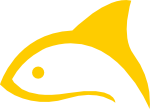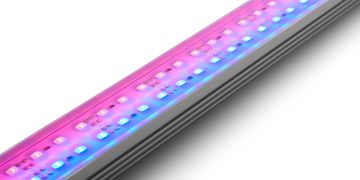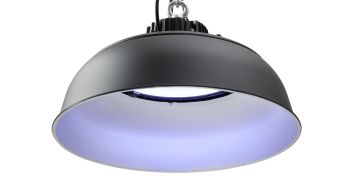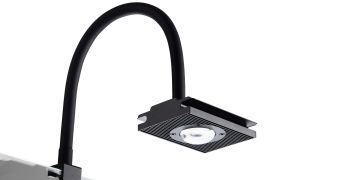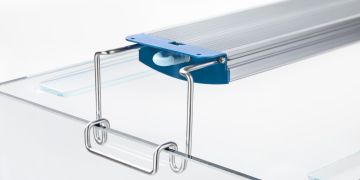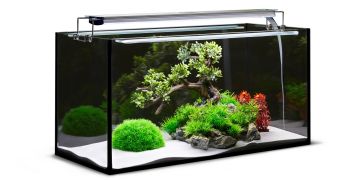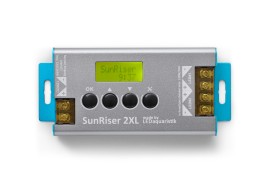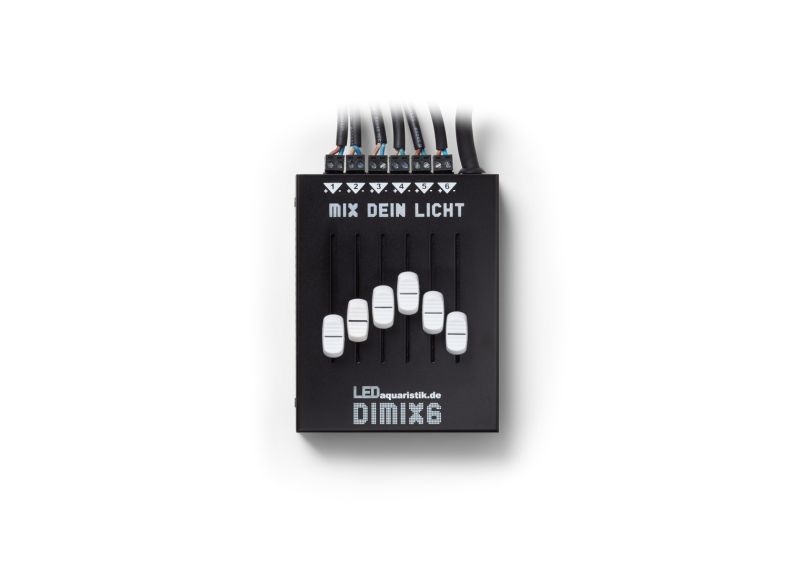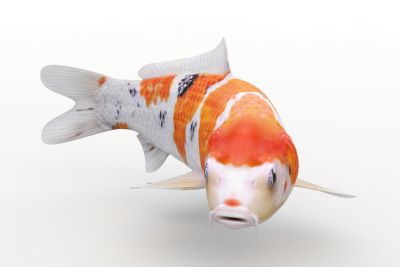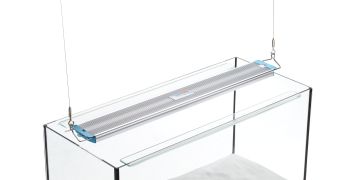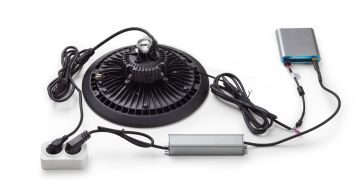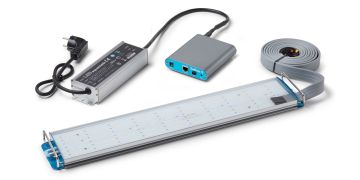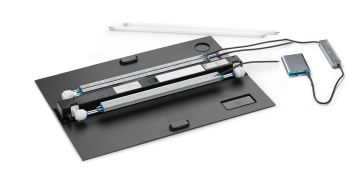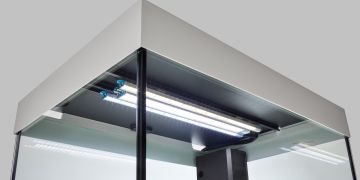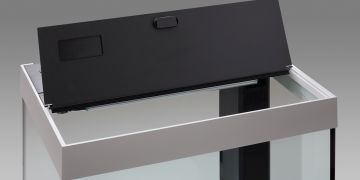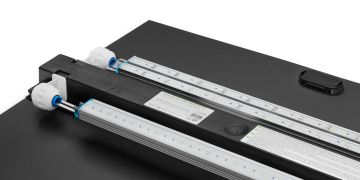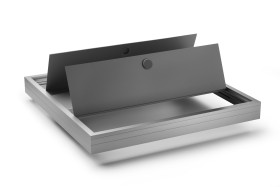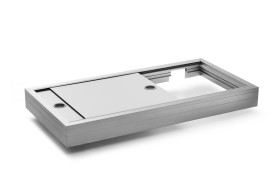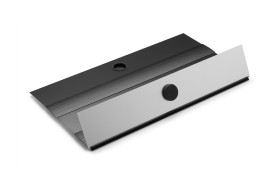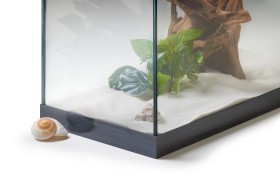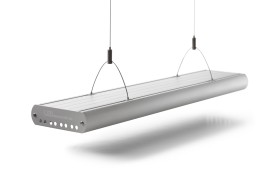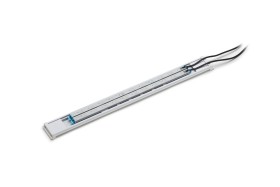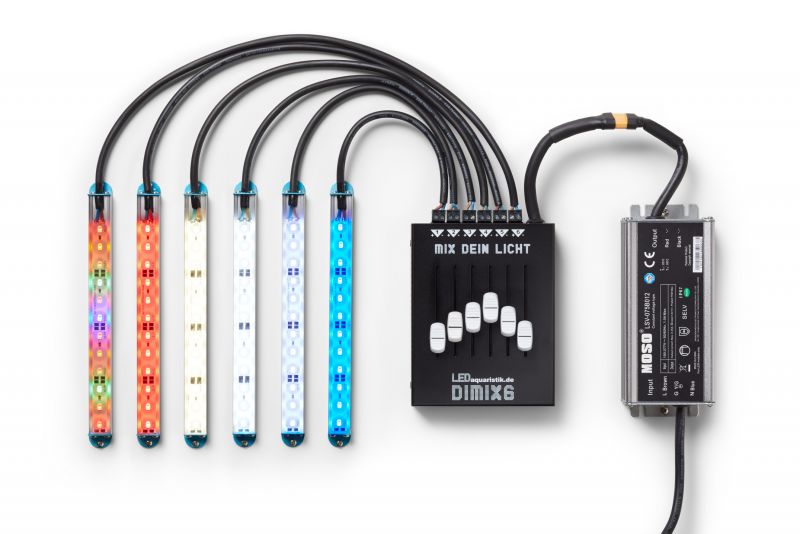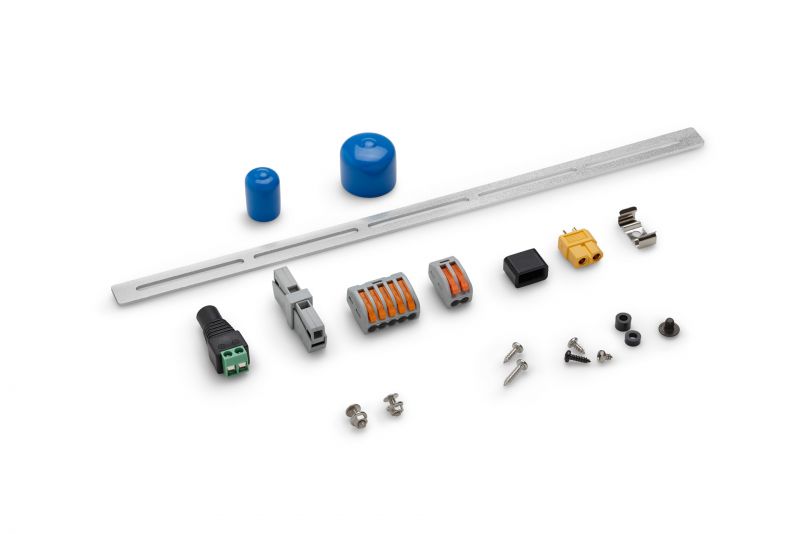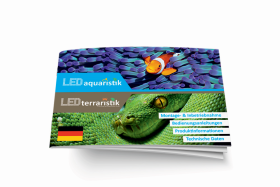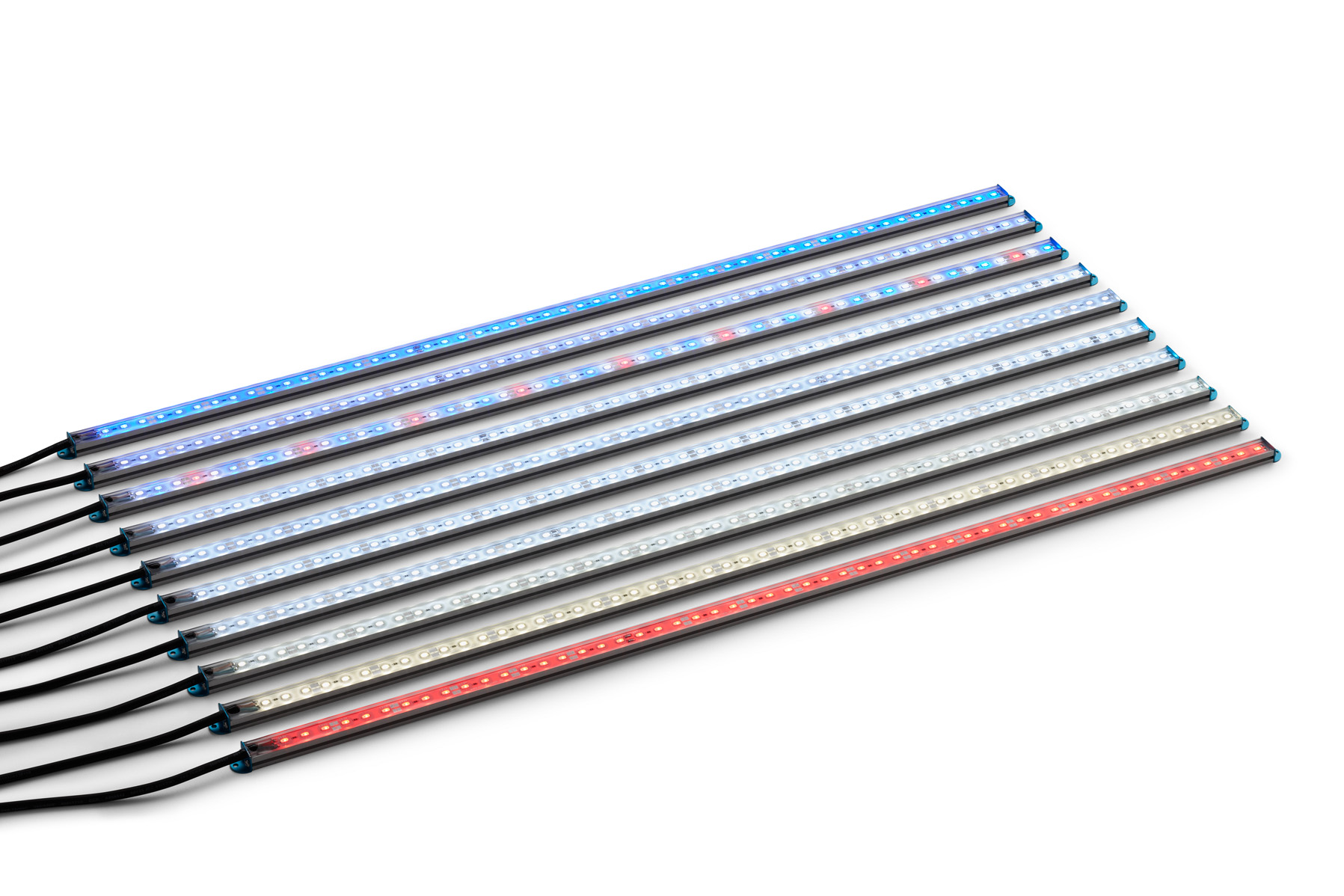FAQ frequently asked questions
A warm welcome to our FAQ section
Here you will find answers to frequently asked questions about shipping and ordering, as well as technical details about our premium aquarium LED strips and light controls.
General | LED bars | Choosing the Right Product | Getting Started | Installation | Water Cooling | Specifications | Power Supply | Light Control | Issues | SunRiser 8 | SunRiser 4 / 6
Of course, we offer attractive shopping cart discounts for your orders. Depending on the value of your purchase, you will receive the following discounts:
- 3% discount for a purchase value of €333 or more
- 5% discount for a purchase value of €555 or more
We want to ensure that you benefit optimally from your purchases with us. These tiered discounts are our way of saying thank you for your trust in our products. Go ahead, browse through our assortment, and enjoy exclusive benefits as you select your aquarium LED strips and light controls. If you have any further questions, we are at your service.
Service hotline
Mon-Fri, 8:30 am - 12 am and 1 pm - 4:30 pm
Support and counselling via:
+49 (0) 5257 / 93 666 50
WhatsApp
+49 (0) 171 807 84 81
Or via our contact form.
General
- You can return the goods within 14 days of receipt.
- To do so, please use the below withdrawal form and return the relevant items to us with sufficient postage.
- You will receive a credit note or refund after the goods have arrived and been checked.
- For the items you would like to buy instead, place a new regular order via our shop. It is not possible to offset the orders.
Return:
- You can return the goods within 14 days of receipt.
- To do so, please use the below withdrawal form and return the relevant items to us with sufficient postage. The return shipping costs are to be paid by the buyer.
Send to: LEDaquaristik GmbH, Retour, Schierbusch 2, 33161 Hövelhof, Germany - Please also note that we will charge for any signs of use or transport damage. Therefore, please ensure that the items are well packaged.
- A refund will be issued after the goods have arrived and been inspected via the originally selected payment method.
Exchange:
- For the items you wish to purchase instead, place a new regular order through our store. It is not possible to offset the orders.
Excluded from withdrawal:
- Items that are excluded from the right of return include, among others, aquarium covers and additional items that are made to customer-specific measurements and thus are made to order. (U-profiles, E-profiles, gravel trims), see Withdrawal policy
In case of normal order situation, we usually ship within 24 hours after receipt of payment. The delivery of the order within Germany then takes 1-3 days later.
Products that are specially made, or the delivery abroad take about more time.
Our LED-bars
The differences between these products depend on your individual lighting needs. The aquaLUMix provides a compact and highly powerful solution with all the light colors needed for an appealing daylight simulation. It also includes an integrated mount and the ability for heat recovery.
If you prefer a tailor-made lighting solution, then eco+ or PRO² might be a better option. These modular systems allow additional control over the arrangement, quantity, and length of individual LED bars. The choice depends on your vision of perfect lighting, whether you opt for the ready-made solution (aquaLUMix) or prefer a customizable system (eco+/PRO²).
|
|
eco+ |
PRO² |
aquaLUMix A new record in performance, functionality and quality |
|---|---|---|---|
|
LED configuration |
72 LEDs/m |
144 LEDs/m |
340 LEDs/m |
|
Output |
34W/m |
53W/m |
110W/m |
|
Lumens |
Up to approx. 3800 lm/m |
Up to approx. 6500 lm/m |
Up to approx. 14000 lm/m |
|
Efficiency |
Up to 112 lm/W |
Up to 123 lm/W |
Up to 140 lm/W |
|
Available light colours, variants |
12 |
11 |
4 |
|
Available lengths |
7 (20-140cm) |
6 (47-135cm) |
7 (24-144cm) |
|
Cooling |
Passive by |
Passive or |
Passive or Heat recovery (LED water cooling = aquarium heating) |
|
Design |
Slender, lightweight |
Compact LED bar |
Solid, preconfigured Compact lamp incl. mounting solution |
|
Cross section |
18x12mm |
32x18mm |
94x28mm |
|
Max. configuration of |
4x eco+ LED bars in parallel |
2x PRO² LED bars and |
1x aquaLUMix |
The cable length for the eco+ and PRO² LED bars is 150cm. In order to extend the cables of the LED bars (150cm), which may be too short (to the installation site of the control unit), I recommend the extension cable by the metre with the solder connectors.
For the aquaLUMix, powerBEAM and multiBEAM products, the cable length is 250cm and should not be extended.
A maximum cable length should always be kept as short as possible. There is a purely physical reason for this: the longer the cable, the higher the voltage drop, the less efficient the lighting. In addition, long cables behave like an antenna; the susceptibility to interference increases massively with the length of the cables. More than 3 m should therefore be avoided if possible.
The cable length of the power supply units is approx. 50cm on the input and output side.
We have tested RGBs extensively. The light produced, especially the white, which is probably mainly used, looks very unnatural or cold and artificial, usually with a blue tinge. You need to know that white light in RGBs is produced by mixing red, green and blue colours. Thus, the colour rendering quality and especially the light output falls far behind that of single-colour LEDs.
The fact that white light within an RGB chip is generated from the primary colours red, green and blue leads to another disadvantage. An RGB chip can only reproduce one light colour at a time. Example: White light for main lighting and a slowly appearing reddish light for a sunset are not possible. With RGB, all the light would turn red...from white to pink to red. With single-colour LEDs, you can have red, blue or white LED bars shine as you like, simultaneously or overlapping at different times.
LED bars are typically not available longer than 140 to 144cm as this is the maximum physical length. The reason for this is related to voltage drop: The longer the LED bar, the higher the voltage drop, and the less efficient it becomes. Therefore, anything over 140cm would hardly be economical. To create longer lighting solutions, one can combine various shorter LED bars, such as 2x100cm, 2x80cm, 80+100cm, etc.
As you probably already know, LEDs are sensitive to heat. A high luminous intensity inevitably also leads to a high LED operating temperature, which in turn has a direct effect on the service life of the LED. For this reason, a crucial and indispensable consideration in the design of LED products is how they cope with heat.
Ideally, the LEDs should be mounted "bare" on a good cooling body. The area of use – in aquariums – also makes it essential for the LEDs to have a watertight seal. There are three materials available for achieving all this: Epoxide (synthetic resin), polyurethane (PU) adhesive and silicon.
Most waterproof LED bars available on the market are sealed with epoxide, which means they are very inexpensive. However, from a technical point of view they are not the best choice because they quickly discolour and become brittle.
ClearSealing is a special production process in which a special high-performance silicone gives the LED bars a watertight seal. UV and temperature stable! Although this process results in longer production times and higher manufacturing costs, the characteristics it produces cannot fail to impress:
Temperature:
- Our silicone has a much higher thermal conductivity than epoxide or PU and therefore has almost no effects on the service life. Our LED bars have the big advantage that the LEDs are permanently and directly attached to the cooling body. Thus the heat they create is directly and efficiently conducted away.
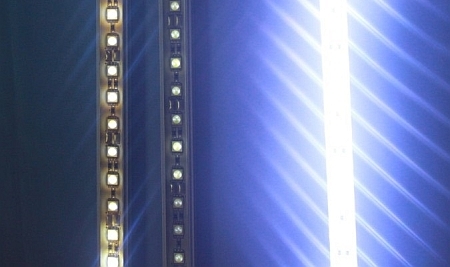
Left: LEDs in epoxide after 3 and 5 months respectively, right: LEDs in silicone after 6 months
External influences:
- The chemical properties of epoxide and PU make the materials highly sensitive to external influences such as heat and moisture. Therefore they can quickly become very hard, stiff and brittle, which adversely affects their role as sealants. Our silicone is much more stable and retains its properties.
Transparency:
- Our silicone is highly transparent, whereas epoxide and PU increasingly reduce the luminous intensity.
Beam angle:
- The production process is specially designed for the materials used and their properties. Thus we are able to achieve a beam angle of almost 160° with ClearSealing technology. And we do that completely without reflectors or lenses!
UV stability:
- Our silicone is much more UV stable. Epoxide and PU go yellow by comparison after just a few months even with a low proportion of UV light.
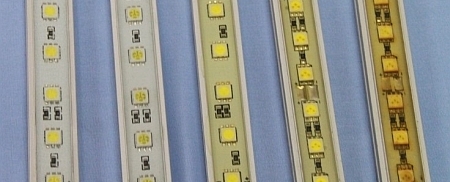
Left: LEDs in silicone after 1 + 3 months, right LEDs in epoxide after 1,2,3 months respectively.
Yes, all our LED bars (eco+, PRO², and aquaLUMix) as well as the spotBEAM and powerBEAM pendant lights are dimmable.
Can I simulate daylight with your LED products?
The lifespan of LED bars is about 40,000 operating hours under optimal conditions and proper care. This includes measures such as: regular external cleaning, using the CleanCover, avoiding heat build-up, avoiding persistent excessive wetness (not humidity), etc. Water cooling with the PRO and aquaLUMix products can be helpful but is not mandatory if there is sufficient ventilation.
Yes, of course, you can create your desired lighting effect with a mix of eco+ and PRO² LED bars. Our mains adapters and controls are compatible with both models (12V DC). In the choice of your LED bar holders, we would draw your attention to the instructions in the product descriptions. For example, the PRO² LED bars are compatible with only the "solo" version of our T5/T8 holders. The lamp housings can be configured either with a maximum of 4x eco+ or 2x PRO² and 1x eco+ LED bars.
The aquaLUMix can also be electrically combined with the eco + or PRO² LED bars in one system, but the fastening is done separately.
Yes, of course, but the following must be taken into account.
Compared to fresh water, seawater is an extremely aggressive medium and only very few materials can withstand direct and permanent contact. In order not to unnecessarily shorten the service life of the LED bars, appropriate precautions should be taken when using them in seawater. In addition to the CleanCoverns, an additional glass or acrylic pane on the aquarium is highly recommended to keep seawater away from the LED bars.
Depending on the size of the aquarium, our first recommendation is always aquaLUMix, spotBEAM or powerBEAM SEAWATER. With this lighting, you get an ideally balanced spectrum on the one hand and a lot of power on the other. To achieve an even more dominant blue peak in the spectrum or even in the UV range, these lights can be wonderfully combined with the eco+ ROYAL BLUE or the PRO² with UV.
To achieve the same performance values with only the individual eco+ or PRO² LED bars, a large number of units would be necessary, which complicates the entire handling up to the control unit.
The following applies to the eco+ and PRO² LED bars: The light colours REEF (11,000K) and CORAL (50% white, 33% blue, 17% red) together with the light colours POLAR (7,500K), MARINE (13,000K) and ROYAL BLUE (460nm) form a wide range for the best possible lighting of marine aquariums. Depending on the requirements of the stock, an individual light mixture can be selected in this way. You would have to determine the final number yourself; depending on the requirements of the stock, a corresponding number of LED bars are used. As a rough guide, at least 50% of the conventional light output should be selected in LED. So, for example, if you used to use 100W tube lighting, you should now use at least 50W LED lighting.
If the aquaLUMix or PRO² LED bars are chosen and the heat recovery function is to be used, we strongly recommend using the TITAN extension.
Yes. Our LED lamps are so effective and bright that they can be used for terraristics. LED lighting with the PLANT-GROW, among other things, is recommended, especially with a view to the planting.
However, since an enormous variety of different animal species can be considered for a terrarium, the stocking should be given special consideration when selecting and purchasing the LEDs. For technical reasons, normal LEDs quickly lack the UVA range completely, so it makes sense to use an additional light source if your terrarium or animals need to die. For this purpose you will find the PRO² LED bar in the MIX variant UVA ✚ SKY-GROW - full spectrum 2.0. This is perfect for use in terraristics, please note the product description!
Advantage in addition to the power consumption: LEDs only develop a small amount of waste heat, whoever uses them as additional lighting does not have to pay attention to additional heat development in the terrarium. Thanks to the special sealing of our LED strips (protection class IP67), use in high humidity is also possible without any problems. The CleanCover is also strongly recommended here.
We have complete confidence in LED bars made by brand-name manufacturers such as LG. We use an extremely efficient 5630 SMD LED with an excellent colour rendering index of up to 90 Ra (CRI)! These LEDs are perfect for use in aquariums, which demand very good colour rendering.
Why 5630/573 SMD LEDs?
- High brightness combined with low electricity consumption
- Very good colour rendering
- Long service life
- Very good price/performance ratio
Here is an overview of the SMD LEDs available on the market and their characteristics:
|
|
Ordinary standard chips |
Ordinary standard chips |
LG - high-power chips LEDaquaristik.de |
|---|---|---|---|
|
Chip type |
SMD 3528 |
SMD 5050 |
SMD 5630 |
|
Dimensions |
3.5x2.8mm |
5.0x5.0mm |
5.6x3.0mm |
|
Output |
0.08W |
0.24W |
0.3W |
|
Lumens |
3-8 lm* |
12-20 lm* |
>35 lm* |
|
Theoretically an SMD 5050 is 3-times brighter than an SMD 3528. |
|||
SMD stands for Surface-Mounted Device: In contrast to other LEDs, SMD LEDs are not connected by wires but are soldered directly onto the printed circuit board.
Advantages:
- Very low heat emissions
- Low voltage and current requirements
- Compact size
- More tolerant of mechanical vibration loads
- Low terminal resistance and impedance
- Low weight due to the absence of connecting wires
Choosing the Right Product
Our LED bars are specifically designed to cater to a wide array of needs and applications. Here are the specific possibilities:
eco+ LED bars: An offering of 12 single-color light options, suitable for various environments and requirements.
PRO² LED bars: 2 separately controllable light colors with a total of 8 combinations to choose from, to meet specific lighting needs.
aquaLUMix: Depending on the purpose, there are pre-configured light setups like FRESHWATER, AMAZON-GROW, AFRICAN-SUN, SEAWATER, divided into 4 separately controllable channels.
easyBEAM and flexBEAM: Pre-configured LED combinations as per need, like PLANT-MIX, DAY, SEAWATER, or DEEP BLUE, provide flexibility and convenience.
powerBEAM: Similar to aquaLUMix with pre-configured light setups like AMAZON-GROW, AFRICAN-SUN, SEAWATER, where the main light and white/blue moonlight are separately controllable.
Our light colors, including PLANT-GROW, GROWx5, RED, SUNSET, TROPIC, DAY, SKY, POLAR, REEF, CORAL MIX, MARINE, ROYAL BLUE, are either available as individual LED bars (eco+) or partially as MIX LED bars (PRO²). This range enables promoting optimal growth of plants, enhancing the appearance of aquariums, or creating special light effects like sunrise and sunset.
Based on our extensive experience, we use a mix of these light colors in all other LED lighting solutions to provide the best lighting solution for your specific requirements.
Modul system eco+/PRO²
A convincing daylight simulation can be achieved with 2 light colours, e.g. SUNSET and DAY. Whether to use RED instead of SUNSET for sunrise and sunset is largely a matter of personal taste. The same applies to the actual "daylight". Our customers use everything from TROPIC, through DAY to MARINE.
Because plants and fish exhibit an infinite variety of colour, it is impossible to say what would be a perfect configuration. If it were possible, we would not offer today's 10 different colours ;-) but with this range of colours everyone is able to compose optimum and individual lighting conditions for their aquariums, be they East African, Amazonian, Asian etc.
If you prefer bluish colours, you should consider SKY, POLAR, REEF etc. Whereas, if orange and red colours are preferred or you have luxuriant planting schemes, the light colours SUNSET, TROPIC, DAY would be a good combination. RED and ROYAL BLUE come into play for creating special accents and effects.
Because our customers occasionally become uncertain when faced with such a wide choice, we suggest the following:
with a colour combination of SUNSET, DAY, POLAR (or if preferred TROPIC, DAY, SKY), the colour spectrum is well and broadly covered, which means it is difficult to go wrong. See Light comparison. Our experiences with this composition and planted aquariums have been very good. These light colours are also very suitable for daylight simulation systems. This is our recommended standard configuration.
Whether you choose to have 3 different series of lamps and light colours or restrict yourself to 1-2 depends on your particular aquarium lighting requirements. Depending on your requirements, you can also combine other light colours (RED = dawn reds, ROYAL BLUE = moonlight). Of course, you can add to this very easily at any time in the future. (Assuming the mains adapter has the required capacity)
Compact system aquaLUMix
The question as to the best choice of colour no longer arises with aquaLUMix as, based on years of experience, we've already equipped these compact lights with optimum light combinations. We offer 4 ready-configured lights for freshwater and seawater aquariums in a choice of 5 lengths, from 54 to 144cm. In the case of aquariums of over 144cm in length, two lights are simply combined together.
Depending on the inhabitants and set-up of your aquarium, as well as personal taste, you can choose one of 4 colour combinations - a fitting solution for every area:
- FRESHWATER - Clear, bright colours for outstanding colour rendering, without being detrimental to plant growth. (e.g. for the classic company aquarium)
- AMAZON GROW - A bright, tropical light with a focus on optimum plant growth, including Grow LEDs. (e.g. for thickly-planted Amazon or Asian aquariums)
- AFRICAN SUN - A higher proportion of blue in the daytime light, augmented by a colour-intensifying light composition. (e.g. for cichlid aquarium with Malawis or Tanganyikas)
- SEAWATER - Basically, a high proportion of blue with white and blue light, with additional special colours like red, violet and ultraviolet. (For seawater aquariums)
Every variation of the aquaLUMix is equipped with 4 separately controllable light channels, thus offering incomparable lighting options. Thus, besides light colours for general daytime lighting, LEDs for moonlight and sunrise are also integrated. In addition, a fastener, a splashguard and a water cooling system that can be used if necessary are already included. A suitable mains supply unit and, if desired, a light control or splitter should be ordered separately!
You'll find details on this light and colour configuration in the technical data further down this page.
For a planted aquarium, a special combination of light colors is recommended for vibrant plant growth. The GROWx5 and PLANT-GROW LED bars or those with a higher red component, such as SUNSET or TROPIC LED bars (3500 or 4500 Kelvin), are particularly suitable. A mix of SUNSET, DAY, POLAR (or alternatively TROPIC, DAY, SKY) covers almost the entire color spectrum. These combinations have proven effective and are excellent for day simulation. With less planting, combinations like SUNSET+SKY or TROPIC+POLAR might be a good choice. Red or reddish light, such as RED or GROWx5 and PLANT-GROW, further enhances growth and highlights red plants and fish. Our aquaLUMix compact lights are already optimally configured, with the AMAZON-GROW variant for optimal plant growth including GROW LED bars. The choice of light colors may also be a matter of personal taste.
The following example shows a comparison of lighting configurations with and without GROWx5, which makes the basic advantages easier to see:
|
|
GROWx5 - TROPIC - SKY |
SUNSET - DAY - SKY |
|---|---|---|
|
Brightness |
|
|
|
Lumens |
Σ 4048 lm |
Σ 5334 lm |
|
Colour spectrum |
|
|
|
Photosynthesis / growth |
|
|
|
|
|
|
|
Colour rendering (CRI) |
|
|
|
Photographic comparison |
|
|
|
|
For further combinations see Light comparison |
Logic tells us that there are unlimited possibilities for combining our light colours. Of course, GROWx5 bars may also be combined with 1 or even 3 additional light colours. The advantages and disadvantages mentioned above must then be weighed up. And last but not least, the number of LED bars always depends on the type of lighting you want....!
For aquariums ranging in length from 120 to 140 cm, a single LED bar may be sufficient. However, the number of required LED bars depends on several factors:
- Aquarium Size: For example, a 120x50x50cm Malawi Lake aquarium is illuminated with one 50% dimmed LED bar, while a 300x90x70cm aquarium requires two bars.
- Plantation: Heavily planted Amazon aquariums around 120cm require two or three LED bars.
- Floor Color: A dark floor requires more light as it does not reflect light like a bright floor does.
- Demanding Plants: More light is needed for dense or demanding plantings.
- Individual Taste: Everyone has different preferences and expectations for lighting.
See Photos of our customers for further details.
Here is a non-binding overview to help you decide on the number of LED bars:
|
Degree of |
Plant light |
Number of eco+ LED bars |
Number ofPRO² LED bars |
Number of aquaLUMix lamps |
|---|---|---|---|---|
|
None or light |
|
1 |
1 |
1 |
|
Medium |
|
2 |
1-2 |
1 |
|
High |
 |
3-4 |
2 |
1 |
|
Extreme |
|
4+ |
2+ |
1-2 |
|
The values relate to average tank heights and widths of about 60cm. The arrangement of the bars, central, offset, split, or placed next to one another is completely up to you. As is the choice of light colours! |
||||
